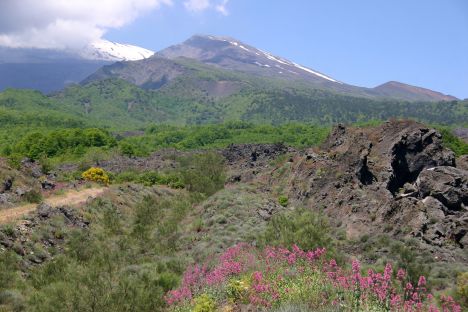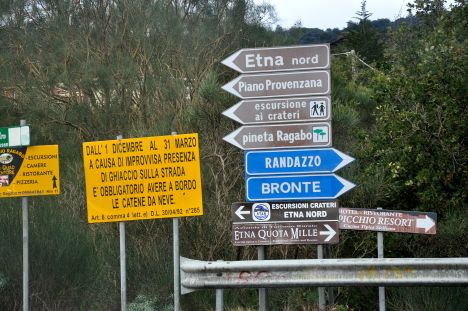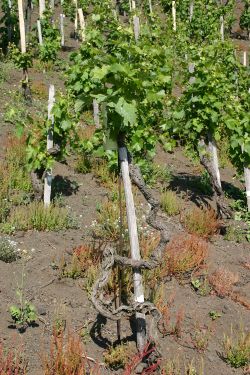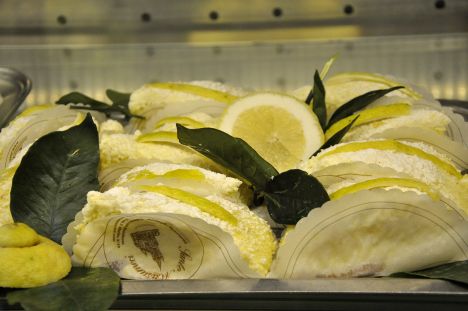The Nerello Mascalese variety produces wines of unimagined finesse at the heights of Etna. The complexity and elegance of the best Etna wines are in no way inferior to wines from Burgundy, Valtellina, Montalcino or the Langa. This discovery is not new; Etna's red wines have long been known to connoisseurs for their finesse. But despite the international format of the wines, things are leisurely in the villages of Etna. Hardly any wine tourists, no price hustle around the vineyards, very few good restaurants and hotels, a slow increase in the number of labels.
Actually, one should make a pilgrimage to Etna at least every two years. After all, we also go to Burgundy and Alba regularly. But Etna is Sicily, and Sicily is darned far away even from Tuscany. It's 1,000 kilometres from Florence to the first Etna vineyard by car, and you lose a good twelve hours on the boat from Livorno to Palermo, usually even more. By plane it is faster, but not everyone likes this means of transport, a rental car is unavoidable, and you usually spend the first few days without luggage. Either way, a trip to Mount Etna is expensive and time-consuming. That's the only reason why we don't visit Sicily more often. Since it's not just us, it stays quiet on Etna and the winegrowers' guild among themselves.
The wide landscape in the north of Etna - the best vineyards are there - impresses not only wine lovers. On the short drive from Randazzo to Passopisciaro, the road crosses huge, cooled lava flows. They are black scree deserts, greyed by lichen growth. Nothing grows there, only at the edge of the solidified stream are oaks and Mediterranean scrub on barren land between rocks.
The view up to the 3,340-metre summit is reassuring, however; above icy slopes, Etna lets a peaceful plume of smoke rise.
But the old smoker has only apparently become tame. For when he is in a mood, he stages monumental fireworks displays. In 1981, he sent a glowing stream of rock near Randazzo all the way down to the Alcantara River. Again and again he proves his unpredictability and explodes in unexpected places, opens new craters and chasms, offers unique pyrotechnical spectacles, causes fear and destruction.
While writing these lines, an email from a South Tyrolean friend on a trip to Sicily reached us: "We were at the top, at the highest vantage point, when the plume of smoke grew larger and larger and the guides gave the order: Get out of here immediately! As soon as we arrived at the mountain station with the Unimog vehicles, it started: lava stones several centimetres in size fell from the sky, like in a hailstorm. In a short time, the snow fields were dark grey, and down at the valley station the cars were covered with ash." The Sicilians just know how to offer the tourists something!
Even the vineyards further down - they reach up to 1,000 metres and higher - the houses and towns are not safe. In 1669, a lava flow ran through the middle of Catania into the sea and pushed it back a few hundred metres. In 1928, the town of Mascali - which gives its name to the Nerello Mascalese - was reduced to rubble. There is hardly a village in the landscape around the crater, which has been repeatedly reshaped by lava flows, that has not been destroyed or threatened in the course of the past centuries.
 |
| It was only centuries after the lava had cooled that the Mediterranean flora began to colonise it. (Photo: Merum) |
But the volcano does not only bring destruction. The fertility of what it hurls at the land in its fury has always attracted people. Over the centuries, the lava weathers into black dust rich in minerals. The vine loves these soils and produces very special wines here.
The best vineyards lie between 600 and 1,000 metres above sea level and sometimes higher. During the day, the sun heats the vineyards with Mediterranean power, but at night the temperatures drop by 20, sometimes even up to 30 degrees: these are perfect conditions for delicate wines.
When the DOC Etna was established in 1968, the cultivation zone was limited upwards. The reason for this was that these high sites were no longer cultivated at that time anyway. Today, however, there are vineyards there again, some of which are really top vineyards. However, everything higher than the DOC limit must be bottled as IGT or, more recently, as DOC Sicilia.
Two of the best producers have sites above this limit: Planeta and Passopisciaro. This is also the reason why these producers do not label their wine as Etna DOC. Alessio Planeta: "Today, our Etna wines are still labelled as IGT Sicilia, but from 2013 onwards, the two wines from the highest sites will be marketed as DOC Sicilia, the others as Etna DOC."
The winegrowers would like to change the production regulations, as they are no longer up to date, since wine is once again grown at altitudes of up to 1,300 metres. But apparently this is not an easy undertaking. Because with every change, other demands can also be brought in. For example, certain producers, those with vineyards at low altitudes, would also like to see their wine recognised as Etna DOC. But this, in turn, does not suit the farms at high altitude, because the lower the sites, the more rustic and simple the wines. It is the altitude that makes the Nerello something great!
The Italians know very well that appellations are useful and necessary, but unlike the French, they do not love them. That is why secessionist voices are spontaneously raised in such situations. There are some here who want to create a new DOC: the "Alta Quota" (high altitude).
Merum says: a crazy idea! Why not compromise on the DOC Etna, integrate the high sites and accept lower ones as the price? Gradually, a site classification could be introduced, an official or a de facto classification, dictated by the market. "Etna" is well known and is tentatively beginning to take hold as a wine brand. To create a competing appellation now would not only create new marketing problems for the exiting wineries, but would also weaken the existing DOC Etna.
 |
| The crater is on the left. (Photo: Merum) |
The main cultivation areas on Etna are in the north and east of the volcano. Giuseppe Benanti from Viagrande: "While we harvest here already in the third week of September, the grape harvest in the north starts four weeks later."
The higher and more north-exposed the vineyards are, the later the harvest can take place. In the north, Nerello is not harvested until around 25 October to mid-November. Graci: "Last autumn I picked the last grapes only on 5 November and they were perfect. On Etna, the grape harvest is always a difficult undertaking because it usually rains a lot in October and November. Last year it was relatively dry, but that was the exception."
Generally speaking, when grapes ripen at high temperatures, it may produce good wines, but inevitably wines with jammy fruit, degraded acidity, no finesse. If the red wines of Etna, like those of Burgundy or Valtellina, have this incomparable elegance, they owe it not least to the low temperatures during ripening and harvesting. As in the Langa in the past, snow may fall on Etna during the grape harvest.
The climate on Etna is rainy. It rains often, especially in the southeast, with up to ten times more precipitation than in the rest of Sicily.
In the high vineyards to the north of the volcano, the grape harvest is not only delayed compared to lower and warmer locations. Due to the shorter sunshine duration and the harsher climate, the entire growing season is delayed. This results in completely different wines. Thus, the reds from the north side appear somewhat more austere than the wines from the east side, especially in their youth. They have rough edges, more energetic tannins, higher acidity and less colour, but their fruit is more profound and the wines can be uniquely fine.
It is interesting to hear what Alessio Planeta says about the harvesting process on his farm. Planeta owns vineyards in western Sicily (Menfi), in the south (Vittoria and Noto) and in the northeast (Etna and Mamertino). Alessio Planeta: "Our grape harvest lasts 90 days! I start at the end of August with the early ripening grapes in Menfi and finish at the end of October with the Nerello Mascalese on Etna." That's Sicily! Not a uniform wine region, but a small continent with the most diverse growing conditions - and the most diverse wines!
 |
| Nerello vine in the black volcanic soil. (Photo: Merum) |
According to the production regulations, up to 9,000 kilos of grapes per hectare may be harvested for the red Etna DOC. But this is theory, especially in the best sites with old Alberello vines. Alberto Graci tells us about his 2009: "I only harvested 1,000 kilos per hectare. It was a difficult year. But the little wine we made was magnificent. It was so far the most elegant wine I have ever made." That's 1,000 bottles per hectare.... If they cost as much as they should in terms of effort, they would be more expensive than the most famous Premiers of the Côte de Nuits and the best Barolo....
The classic vine training on Etna is the pruning, called Alberello in Italy. This vine training is very common in southern Italy, but also in southern France (gobelet, the French term), but is increasingly disappearing to make way for the more low-maintenance wire-frame forms.
The vines, tied to chestnut sticks, are a good metre apart, so there are around 8,000 plants per hectare. The soil is worked in flat vineyards with small machines, but on slopes by hand with hoes, uphill, vine by vine, metre by metre....
Once harvested, the Nerello remains on the mash for ten to 15 days at the Passopisciaro winery. After fermentation is complete, it is drawn off and pressed. The young wine is then put into 5,000-litre oak barrels, where the malolactic fermentation also takes place. A further year and a half in wooden barrels is used to age the wine.
At Benanti, on the other hand, the red wines remain on the mash for around 25 days. This extracts a lot of colour and also tannins. Giuseppe Benanti: "It is not without reason that our wines are only put on the market after four years. After fermentation, the wines are filtered and then go into barriques." Russo also works with small containers: "For space reasons, I only use barriques, but as soon as the new cellar is finished, I will acquire large wooden barrels." In fact, we were bothered by the strict wood character in wines from these two producers.
Tenuta di Fessina works with different, but mostly large wooden barrels. It is purely a matter of taste which of their two Etna DOCs we like better. Certainly Fessina's top wine, the Musmeci, is the richer, more complex wine, but for our taste it is at its limit with the wood, especially in its youth, while the first is the simpler wine, but without any wood and wonderfully fruity and drinkable.
Alberto Graci, vice-president of the Etna Consortium: "The total DOC production is around 1.5 million bottles. Of these, one million bottles are red Etna DOC, the rest is white." Etna DOC white wine is made from Carricante grapes. Actually, this variety is extremely interesting. However, we are currently not convinced by the white Etna wines, as they are often too conspicuously marked by new oak.
Signs that the appellation is commercially still at the very beginning of its career can be read from the following facts: 3,120 hectares are approved as a DOC area according to the Federdoc (umbrella organisation of Italian protection consortia). In reality, however, only 400 hectares produce Etna DOC. While the consortium speaks of one million bottles of red DOC wine, i.e. 750,000 litres, according to Federdoc, however, 1.8 million litres of red Etna DOC are produced. This means that more than half of the DOC wine is not bottled in the end, but sold as table wine.
How many producers from Etna do you know? Five? Ten? Giuseppe Russo: "There are about 60 bottlers registered with the Chamber of Commerce on Etna. Fifteen years ago there were maybe ten. Only a few of the 60 producers are also internationally known. The majority of them sell only locally or regionally." Behind a deserving vanguard of sometimes unforgettable wines, a few dozen winemakers wait in anonymity, ready to follow as the appellation becomes more successful. So the future should bring us Etna fans an increasingly diverse range.
 |
| Aromatic lemon slices are also a Sicilian speciality. (Photo: Merum) |
The wines of Etna have always had good sales. Wineries in northern Italy and central Europe not only needed full-bodied, fruity Nero d'Avola, they also needed wines with a lower alcohol content and more tannin for their blends. In addition, the Etna winemakers met the demand of the commercial wineries of the nearby seaside towns and quenched the thirst of the tourists.
Federico Curtaz (Tenuta di Fessina) knows: "In the 19th century there were 50,000 hectares of vines on Etna, everything was full of vines." Vincenzo Lo Mauro (Passopisciaro) confirms: "The slopes of Etna were covered with vines, mainly Nerello, up to 1,300 metres. The yields per hectare were enormous, with one vine bearing up to four kilos of grapes." It is said that over 100 million litres of wine were produced on Etna at that time!
"Already in the 19th century," says Curtaz, "Etna was of great importance for Sicilian wine production. However, the wines were never sold as Etna's production. The wines started their journey into the big, wide world from the port of Riposto north of Catania. The shipping documents said 'Vino Rosso di Riposto', no trace of the actual origin."
Alessio Planeta: "In the past, the winegrowers sold their wine openly to the nearby restaurants of Taormina and Catania. And they were not badly paid for it. The prices for open wines from Etna were far above average, and the winegrowers could make a good living from it. If they had bottled at that time, it would only have been an unnecessary expense for them."
But about 30 years ago, the blended wine business collapsed, and local wine consumption also steadily declined. Lo Mauro (Passopisciaro): "The demand for open wine declined rapidly. But instead of marketing their wine themselves, the winegrowers let the vineyards wither away. Today there are still around 3,000 hectares of wine on Etna." Curtaz: "Unfortunately, there are no more than 3,000, 4,000 hectares. Most of the terraces are abandoned and overgrown."
But now Etna is coming back into fashion. Among a very special group of wine lovers, anyway. For these people, who are used to experiencing their moments of wine happiness with fine Pinot Noirs, Grumello or Sassella, Ghemme and Gattinara, Grignolino, Nebbiolo or Barbaresco, the wine world has become a valuable bit bigger thanks to Etna.
Even before the rediscovery of Etna's wines, a small handful of wineries had already made a name for themselves. Benanti, Murgo or Barone di Villagrande are certainly worth mentioning. But they were regarded more as static insider tips than as protagonists of a development. Things were set in motion by the newcomers. First and foremost the owner of the Tuscan wine estate Trinoro, Andrea Franchetti (Passopisciaro), the Italian-American wine broker Marc de Grazia from Florence (Tenuta delle Terre Nere) and Planeta, who have all bought land here in the past 15 years.
Alessio Planeta: "The Etna wine world needed people like Marc de Grazia and Andrea Franchetti, who recognised the great potential from the outside. The local winemakers were shaken up by this. De Grazia and Franchetti understood that Nerello Mascalese had to be treated in a similar way to a Nebbiolo or a Pinot Noir."
Federico Curtaz (Fessina): "A lot has happened here in the last few years, many have invested here, although wine production on Etna involves enormous costs and the lack of infrastructure is a problem for the winegrowers."
 |
| Tending the vines is only possible by hand in the historic vineyards. (Photo: Merum) |
Alessio Planeta: "Life on Mount Etna is still strongly influenced by the agricultural rhythm. That is precisely why it is a world that fascinates me and also many others. If you go to the bar in Passopisciaro today, every few minutes you can meet someone who is here precisely because of the wines. It could be an international wine journalist or Piero Antinori himself. Etna is one of the most sought-after wine-growing regions in Italy at the moment. There is a lot of curiosity."
Vincenzo Lo Mauro (Passopisciaro): "With the arrival of Franchetti and some others, the north of Etna has started to live again. When he came here back then, there was still a lot of land to buy; today it is not so easy to find good locations. A lot of land has already been bought, and the owners are waiting to see how the market develops and whether it is worth planting more vineyards at all. Some also fear that the international Etna interest is just a passing fashion."
Alberto Graci: "Thanks to the good mood among the producers, we have managed to get the wine world interested in us relatively quickly. We work well together, meet regularly, taste our wines together. All this contributes to the growth of the wine-growing area. I don't like to talk about my winery, but prefer to talk about the Etna growing region as a whole. And not only I see it that way, but also my colleagues. We are a group of winemakers who have great respect for the terroir. First comes the appellation as a whole, then the individual wineries. That's very rare, especially in Italy, but in my opinion it's the key to success. Chance has brought all these people together here, Frank Cornelissen, Marc de Grazia, Andrea Franchetti.... I didn't know any of them before. In the meantime we have become friends and together we have brought this land back to life."
Salvatore Scilio (Scilio): "As long as the foreign investors respect the territory and the originality, they are welcome. But if they come here just to speculate, it can become a problem. Fortunately, the newcomers so far appreciate the enormous value of Etna. Our winery has also benefited from others doing marketing for the growing area. Well-known names help the whole appellation. What's great is that everyone is aiming high for quality, you hardly find bad wines anymore."
Those who don't know Etna up close might fear colonisation by foreign capital in the style of Maremma. This danger does not exist! Because on Etna, the difficulty for those willing to invest is finding larger, contiguous parcels of land in the first place. The cultivation area of Etna is very fragmented, so that it is very difficult to bring together vineyards of one hectare or more. Besides economic thinking, a good portion of idealism is needed to get something going here.
This is a very likeable side of Etna: the producers all meet on an equal footing, local winegrowers and foreign wine entrepreneurs. The same conditions prevail for all, there are no large wineries and no mega-wineries, the vineyards are mostly of small dimensions, the vines are dense, mechanisation is only possible to a very modest extent, the production costs are high for all.
The cementing influence of the newcomers is amazing and unique. Contrary to what one might assume, the winegrowers' community did not drift apart due to the investors coming from the most diverse regions, but rather moved closer and closer together in recent years. One example is the event "Le Contrade dell'Etna" in honour of the Nerello Mascalese, which was initiated by Andrea Franchetti: A regular meeting for all Etna winemakers and professional Etna friends in spring. (Ah, if only Sicily weren't so far away...).
Despite its geographical remoteness, Etna is one of the most promising Italian steep-slope appellations. The rise of this wine-growing region is still in its infancy, but the conditions are perfect. Numerous vineyards, long since abandoned, have already been given a new lease of life. Work is being created for the local population, more well-funded wine entrepreneurs will join, money will flow into the municipal coffers, the tourist offer - hotels, good restaurants - will be expanded... Oh, how we would like Sicily to have a Montalcino phenomenon on Etna!
So hurry up: if you want to get to know Etna before the boom, you'd better hurry...
This article was made available to us by the Merum editorial team. Find out more about Merum, the magazine for wine and olive oil from Italy, here:
To the Merum homepage
Order a free copy of Merum
The Etna DOC region in the wine guide of Wein-Plus
All currently tasted wines of the Etna DOC in the wine guide of Wein-Plus
To the "BEST OF Autochthonous White Varieties of Sicily
To the "BEST OF Nero d'Avola from Sicily".
To the magazine article "Sicilia DOC: An island becomes an appellation".